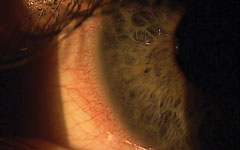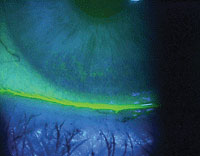 |  |
Many of us have heard the phrase, “if it’s not broke, don’t fix it.” While that holds true for some scenarios, it’s not always the smartest approach to contact lens fitting. It’s worth taking a broader perspective that incorporates technological advancement when addressing certain contact lens situations. You may find a better way of doing things. This month, we look at two cases and discuss ways to break some habits many of us may have developed over time—regardless of efficacy.
Case 1: Children and Contact Lenses
A 10-year-old male patient wants to start wearing contact lenses. His myopic correction has just jumped from a -1.00DS OU to a -2.00DS OU in the past eight months.
Old habits. The most familiar method for this case would be to discuss the various options of contact lenses—from dailies to the reusable two-week or one-month modalities. After that discussion, let the parents decide what they think would work best for their child. Without any information on the differences between CLs, most patients would choose the least costly modality.
New habits. If, on the other hand, we incorporate a broader perspective and take into account the current state of technology, we would start with making a strong recommendation for the new, innovative daily disposable lenses. Research demonstrates that three in five contact lens wearers do not wash their hands prior to handling the lenses.1 The minimized handling that comes with daily disposable lenses is just one reason they are the healthiest and most convenient choice and are now considered the lens of choice for this younger population.
 |
| End-of-day dryness and limbal injection from significant digital device use demonstrates signs of contact lens-related complications. |
Next, consider taking a step further to discuss contact lenses for myopia control. It is proving worth our time to educate patients (or their parents) on certain contact lens options now available that are beneficial for slowing refractive changes at a young age. Myopia control contact lenses offer much promise and may be the next big thing in the contact lens industry.
This area is one of untapped potential and could form the foundation for future treatments for children with developing myopia. Many studies are currently looking at the possibilities, but if we could tell parents they could reduce their child’s vision impairment by a certain percentage (working toward a design or treatment that would reduce myopia by 50%), that would be a drastic improvement worth exploring.
These lenses work by slowing down the patient’s predicted axial length elongation. Through a complicated process, the peripheral retina can mediate refractive development centrally. The peripheral hyperopia can be a stimulus and may even precede the development of myopia. Current theories are aimed at preventing this peripheral defocus at an early age.2 Questions obviously remain, but many researchers are evaluating the role of genetic predisposition, amount of near work, lag of accommodation, vitamin D levels and the amount of time spent outdoors.3,4
Other new treatments such as light filtering spectacle lenses, soft or rigid bifocal or multifocal contact lenses, orthokeratology lenses and pharmaceutical agents (atropine, pirenzepine, 7-methylxanthine) are under thorough evaluation.
As eye care professionals, we see similar cases on a daily basis. Having the tools, technology and research to back up our recommendations is critical. Don’t get stuck in the same old habits or wait too long.
Case 2: Digital Device User
A 30-year-old female patient is currently wearing monthly disposable contact lenses and wants to renew her contact lens prescription. She says she is happy with her current lenses.
Old habits. The most familiar route would consist of performing the examination, checking the patient’s refraction and renewing the same prescription. Rather than trying to upgrade the patient into a newer contact lens technology, it is often quicker and easier to just renew the prescription if everything looks up to par and the patient has no complaints. This is, unfortunately, the more common approach in many offices.
 |
| Dryness from incomplete blinks can happen at any age, especially for digital device users. Photo: Paul M. Karpecki, OD. |
New habits. If we want to remain ahead of the curve and consider the best option available to us, we should start by getting the whole story. Upon further questioning, you find out that this patient works at a bank and spends eight to 10 hours a day on the computer. She has intermittent blurriness (due to a reduced blink rate and incomplete blinking) throughout the day and her eyes look red at the end of the day. The general consensus, after a more thorough session, would be that our patient’s current contact lens regimen is not, in fact, good at all.
As a result of extensive digital device use, today’s patients put new visual health demands on their eyes. Despite all of the advances in contact lens technology, patient discomfort remains a problem. Many are reticent to complain and would rather continue with what they have than deal with alternatives. Patients often imagine the worst, and so avoid confronting the idea of change. This case provides a great opportunity to upgrade the patient into more technologically advanced contact lenses. Patients need a contact lens that can provide all-day visual clarity and comfort.
Instead of providing the same contact lens prescription, consider refitting this patient in a newer design and modality. Many new daily disposable contact lenses have moisture agents embedded in the matrix of the contact lens to help reduce end-of-day dryness and improve all-day comfort. Additionally, consider using a lens that provides improved optical correction while on the computer. This may be an aspheric or a low multifocal design to help with the accommodative demand throughout the day.
Eye care professionals can choose from a wide variety of contact lens materials, designs and modalities that can improve ocular health and visual clarity. Innovative products and research will continue to drive the market. It is vital we stay current with ongoing research in an attempt to break old habits and integrate new and improved methodologies into our practices—a shift that is sure to provide improved health to our patients and growth to our practices.
1. Stone R. The importance of compliance: focusing on the key steps. Poster presented at the annual meeting of the British Contact Lens Association; May 31-June 2, 2007.2. Mutti DO, Sholtz RI, Friedman NE, Zadnik K. Peripheral refraction and ocular shape in children. Invest Ophthalmol Vis Sci. 2000:41(5):1022-30.
3. Mutti DO, Marks AR. Blood levels of vitamin D in teens and young adults with myopia. Optom Vis Sci. 2011;88:377-82.
4. Mutti DO, Mitchell GL, Sinnott LT, et al. Corneal and crystalline lens dimensions before and after myopia onset. Optom Vis Sci. 2012;89:251-62.


